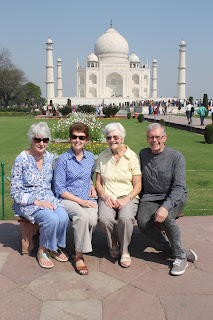Sunday 24th February is well-over a fortnight ago now; the day we had arranged to meet with theological students at Gurukul Theological Seminary in Chennai. Why meet with them?Because twelve years ago, on my first visit, I and a small group of people from "Christians Aware" were taken to the Seminary by the charismatic former Bishop of Madras, Bishop Azariah. It was most-impressive to see just how Gurukul College was engaged with some pretty tough issues, including the one which was highest on Bishop Azariah's agenda, the place of Untouchables in 21st Century Indian Society.
At that time, Bishop Azariah was at the forefront of Dalit Liberation, and he brought to the campaign a Christian perspective. "Dalit" is a Sanskrit word, used by untouchables in India to describe themselves. It means "crushed", "broken", and is how the Dalits see themselves, people who have been oppressed, treated as sub-human, for far too long. My first visit to India in 2001 followed the United Nations Organisation "World Conference against Racism,Racial Discrimination Xenophobia and Related Intolerances", which took place in Durban, South Africa,in August and September that year. Bishop Azariah, a Dalit himself, was a key-speaker at the Durban Conference, where he emphasized that apartheid, now a thing of the past in South Africa, was still a present reality in 21st century India. Bearing in mind that there are some 170 million people classed as Dalit or Tribal out of a total population of 1.4 billion people, then the scale of this problem can be better understood. It is remarkable that more is not said about this, especially in view of the "hype" of India as a developing world leader.
The Dalits, along with "Tribal" peoples, are detailed under Indian law as being of "Scheduled Caste" status, which, thanks to Gandhi, and since independence in 1947,was to give them significant rights and entitlements to make up for the lack of such over the last two or so thousand years.
That's the theory.
In practice, Dalits and "Tribals" are still treated as less-than-human, and the rights that might be theirs under law are in reality out of the grasp of most concerned. That would appear to be true now in 2013, just as is was in 2001, just as it was in 1947.........
The presentation given by Bishop Azariah has been documented in the Conference Report as follows:
"The system of ‘Hidden apartheid’ based on caste practices of distinction, exclusion and restrictions denies Dalits’ enjoyment of their economic, social, political, cultural and religious rights, exposing them to all forms of violence and manifests itself in the segregation of housing settlements and cemeteries, segregation in tea stalls (‘two-cup’ system), denial of access to common drinking water, restaurants, places of worship, restrictions on marriage and other insidious measures all of which inhibit their development as equals."
The question we brought to the staff and students of Gurukul was "What about the Dalits now? Is this still as big a human rights issue as it was in the 20th Century? In our recent Week of Prayer for Christian Unity material was prepared by South Indian Christians, expressing concern still for the plight of Dalits. What should we be reporting back to the UK in this regard?"
To begin with, people in the room seemed reticent to answer this. The reason became clear as we progressed. 80% of the students meeting with us were Dalits. A similar number, 80% of Indian Christians, are Dalits. It is significant that Christ's message of reaching out to those who are broken (Luke chapter 4) really means something in India. It is the "broken", the "crushed", who find something significant in what Christ has to say to them. Some of those present felt that even the Church was not above displaying an attitude of casteism; that it was not always as exempt as it should have been, and that the task ahead of the Church in this regard has a long, long way to go. Others amongst the students talked more-encouragingly of the way in which Dalits were empowering each other and themselves; that things were improving simply because people were determined that they should. The Dalit problem will remain a problem for many years to come, but Dalit determination and resolve to rise above it all is evident.
This Dalit Champion, Bishop Azariah, died nearly a year ago, but there are plenty of good, informed, faithful folk here, who will keep his torch alight to bring this darkest of situations to an end.





